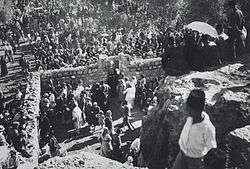Tomb of Simeon the Just
|
| |
 Shown within Jerusalem | |
| Location |
'Uthman Ibn 'Affan Street Shimon HaTzadik, East Jerusalem |
|---|---|
| Coordinates | 31°47′31″N 35°13′50″E / 31.79186°N 35.23062°E |
| Type | burial chamber |
| Site notes | |
| Public access | Free |

The Tomb of Simeon the Just or Simeon the Righteous (Hebrew: קבר שמעון הצדיק; translit. Kever Shimon haTzadik) is an ancient tomb in Jerusalem traditionally believed to be the burial place of Simeon the Just.
History
In the 12th century, Benjamin of Tudela wrote that the tomb of Simeon was at "Tymin or Timnathah", between Tiberias and Meiron.[1] Rabbi Jacob, the messenger of Jehiel of Paris, wrote in 1238–1244 that "the cave of Simeon the Just and his disciples is near Jerusalem".[2] Obadiah da Bertinoro wrote around 1490 that "The sepulchre of the seventy Elders, which lies about 2,000 cubits from Jerusalem, is splendid, especially that of Simon the Just."[3]
The tomb is located in the Shimon HaTzadik neighborhood adjoining Sheikh Jarrah. According to a long-standing Jewish tradition, it is the tomb of Simeon the Just and his students. For centuries the cave tomb was only accessible by paying an admission fee to the Arab caretakers of the site; this was a common arrangement at Jewish and Christian (and Roman) sites in Jerusalem.
In 1876, the Jewish community purchased the site and surrounding land for 15,000 francs. Under the guidance of Jerusalem's chief rabbi, Shmuel Salant, housing construction in the area around the tomb commenced in 1891. By 1948, twenty Jewish families were living in the neighborhood. After the 1948 Arab–Israeli War, the property fell on the Jordanian side of the Green Line, and Palestinian families moved into the homes. This line of events is however now challenged in the Israeli Supreme Court.
During the Ottoman period, Wasif Jawhariyyeh mentions the site as the location of communal festivities known as the Yehudia, attended by Jewish, Christian, and Muslims in honor of Shimon the Just.[4]
While people flock to the tomb of Shimon bar Yochai on Lag Ba'omer to perform the Upsherin ceremony, the Tomb of Simeon the Just is used by many as an alternative location. A 19th century traveller, John Wilson, describes this practice in his book The Lands of the Bible Visited and Described, published in 1847.[5]
Authenticity

In 1871, Clermont-Ganneau discovered
- "a Roman inscription whose existence had escaped the notice of the archaeologists who had preceded me, even as it has that of those who have followed me, for up to the present day no one, as far as I know, has noticed it or mentioned it. It is not graffito, but a large inscription carved in lapidary style in a cartouche with triangular tabs at the ends, engraved on the back wall of the ante-chamber, above the low door, about two metres above the floor of the chamber."[6]
The inscription had been badly damaged by hammering but the first line clearly read Juliae Sabinae, indicating to Clermont-Ganneau that the tomb was that of a Roman woman named Julia Sabina.[6] Clermont-Ganneau surmised that she was the wife or daughter of Julius Sabina, first centurion of the Tenth Legion Fretensis, whose inscription elsewhere showed very similar lettering.[6]
Because of this inscription, and other reasons, several historians and archaeologists have expressed the opinion that the tomb cannot be that of Simon the Just.[7][8][9]
Kloner and Zissu date the tomb to the late Second Temple period.[10] However, because of the absence of the narrow burial shafts called kokhim, they suggest it may have been used to store the bones of people originally buried elsewhere, rather than fresh corpses.[10] Such a need arose when the "third wall" of Jerusalem surrounded many tombs during the first century CE, since Jewish law forbids burials within the city limits.[10] Kloner and Zissu conjecture that the association with Simeon dated from the discovery during the Middle Ages of an ossuary bearing the common name "Simeon".[10]
See also
Simeon (Gospel of Luke), who is also referred to as Simon the Just and Simon the Righteous.
References
- ↑ Marcus Nathan Adler (1907). The Itinerary of Benjamin of Tudela. London: Oxford University Press. p. 29.
- ↑ Marcus Nathan Adler (1930). Jewish Travellers in the Middle Ages. New York: Dover Publications (1987). p. 119.
- ↑ Marcus Nathan Adler (1930). Jewish Travellers in the Middle Ages. New York: Dover Publications (1987). p. 240.
- ↑ "Ishaq al-Shami and the Predicament of the Arab Jew in Palestine". Institute of Jerusalem Studies. August 2004.
- ↑ The Lands of the Bible Visited and Described,
- 1 2 3 Charles Clermont-Ganneau (1899). Archaeological Researches in Palestine During the Years 1873–1874. I. London: Palestine Exploration Fund. pp. 267–270.
- ↑ Simon Sebag Montefiore (2011). Jerusalem: The Biography. Hachett.
- ↑ Jerome Murphy-O’Connor (2008). The Holy Land. Oxford Archaeological Guides. p. 157.
- ↑ Dan Bahat (1990). Illustrated Atlas of Jerusalem. Simon & Schuster. p. 67.
- 1 2 3 4 Amos Kloner and Boaz Zissu (2002). "The "Caves of Simeon the Just" and "The Minor Sanhedrin." Two burial complexes from the second temple period in Jerusalem". In L. V. Rutgers. What Athens has to do with Jerusalem. Leuven: Peters. pp. 125–149.
External links
| Wikimedia Commons has media related to Tomb of Simeon the Just. |